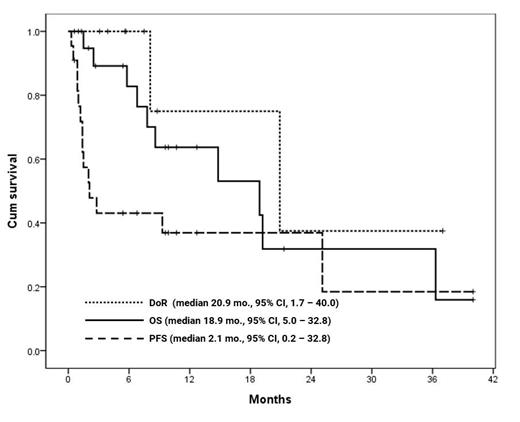BACKGROUND
Primary central nervous system lymphoma (PCNSL) is an aggressive non-Hodgkin's lymphoma confined in the brain and/or spinal cord. While high-dose methotrexate (HDMTX) has been considered the standard of care for newly-diagnosed patients, the optimal treatment strategies for relapsed disease remain challenging, and the outcomes are dismal. Given that 40~50% of PCNSL tissues exhibit aberrancy on 9p24.1 ( PD-L1/PD-L2), immune-checkpoint inhibitors (ICI) may work for the disease. However, there still have been limited data due to the rarity of the disease and the limited accessibility of the drug. To further elucidate the role of ICI in PCNSL, we carried out a nationwide retrospective analysis.
METHOD
Patients treated with nivolumab for relapsed PCNSL were included in the analysis. Medical records were retrospectively reviewed, and characteristics, including age, sex, prior treatment, risk factors, response, and survival outcomes, were collected.
RESULTS
From November 2018 to September 2022, 22 consecutive patients were included in the analysis from 4 tertiary institutes in Korea. The median age at diagnosis was 66, and male: female ratio was 1:1. The histologic subtype was diffuse large B-cell lymphoma in all cases, and in 15 cases of which cell-of-origin was identified, 12 cases (80%) were non-GCB subtype. In terms of frontline-treatment, 21 patients (95%) had received HDMTX + procarbazine + vincristine, and rituximab was administered in 73% (16/22) of patients.
Nivolumab (at a dose of 3mg/kg every 2 weeks) was treated after median 3 lines (range, 2 - 6) of therapy and at the median age of 67 (range, 37 - 82). Four (18%), twelve (55%), and six (27%) patients were classified as low-, intermediate-, and high-risk groups by IELSG criteria, respectively. Eleven patients (50%) were refractory to the last treatment prior to nivolumab. With a median follow-up duration of 22.3 months (95% CI, 13.1 - 31.5), nine patients (41%) had an objective response (6 complete responses, 3 partial responses). The median time to response was 3.0 months (95% CI, 0.7 - 5.3 months), and the median duration of response was 20.9 months (95% CI, 1.7 - 40.0). The median progression-free survival (PFS) was 2.1 months (95% CI, 0.2 - 4.0), and the 1-yr PFS rate was 36.9% (± 10.9%). The median overall survival (OS) was 18.9 months (95% CI, 5.0 - 32.8), and the 1-yr OS rate was 53.1% (± 13.9%). As expected, responders showed a strong tendency for prolonged OS (36.3 mo. vs. 8.6 mo., p = 0.058).
While earlier use (3L vs. 4L or later) of nivolumab was not associated with a higher response rate, it resulted in statistically non-significantly prolonged OS (36.3 months vs. 8.6 months, p = 0.164). Nivolumab was very well-tolerated as no dose reduction was required, and treatment delay was required in two cases (one infection and one seizure).
CONCLUSION
Given that only restricted treatment strategies are available for relapse PCNSL patients, our study suggests that nivolumab can be a suitable option for the disease. Further studies are warranted to determine predictive biomarkers for nivolumab treatment given the excellent survival duration in responders.
OffLabel Disclosure:
Yoon:GI cell: Consultancy; Kirin Pharm: Honoraria, Speakers Bureau; Takeda: Honoraria, Speakers Bureau; Boryung: Research Funding; BMS: Honoraria, Speakers Bureau; Pharos iBio: Consultancy; Novartis: Consultancy, Honoraria, Speakers Bureau; Janssen: Consultancy, Honoraria, Research Funding, Speakers Bureau; Beigene: Consultancy; GC cell: Consultancy; Roche: Honoraria, Research Funding, Speakers Bureau; Abclon: Consultancy; Samyang: Research Funding.
Nivolumab Primary CNS lymphoma


This feature is available to Subscribers Only
Sign In or Create an Account Close Modal